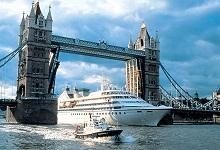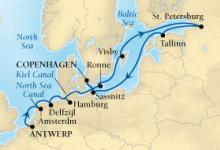Recently Viewed Cruises
- Pride, Baltic Gems & Russia ex Antwerp to CopenhagenAdd to favourites
- Balmoral, Baltic Capitals L1305 ex Southampton ReturnAdd to favourites
- neoRomantica, Scandi Russia ex Amsterdam ReturnAdd to favourites
- Enderby, Russia's Ring of Fire ex Petropavlovsk ReturnAdd to favourites
- Discovery, Baltic Symphony Cruise ex Harwich ReturnAdd to favourites
- Catch up on Cruising: Latest cruise news in bite size
- Royal Caribbean International raises the bar
- Classy Astor fills gap in market
- Oceanic Discoverer
- Ab Fab Oosterdam
- Frequently Asked Questions
-
Pride, Baltic Gems & Russia ex Antwerp to Copenhagen
Nights 14 Ship Seabourn Pride Star Rating 
Departs Antwerp, Belgium Sailing 2013: 27 May Ports of Call Antwerp, Amsterdam, Groningen, Hamburg, Kiel Canal, Ronne, Visby Sweden, St Petersburg More Tallinn, Sassnitz, Copenhagen Please enquire about this cruise for pricing.


14 Night Cruise sailing from Antwerp to Copenhagen aboard Seabourn Pride.
The ship that started it all inspired one critic to declare that "Seabourn is in a class by itself." And in 1988, when the sleek, 10,000-ton Pride emerged from the Schichau Seebeckwerft shipyard in Bremerhaven, Germany, that was literally true.
At that time, most ships of Pride's size (and there were more then than now) carried more than 400 guests. Seabourn Pride, christened by Ambassador Shirley Temple Black, topped out at half that many.
The idea that every guest sailed in an expansive, ocean-view suite was revolutionary. The concept of open-seating dining accommodating all guests was exceptional. And the notion of including nearly everything for the cost of the fare was a rare thing as well. But the most important element of the Seabourn experience, to founding president Warren S. Titus, was the unparalleled level of personalized service provided to guests.
Hand-picked staff, recruited from the finest European hospitality schools and hostelries, are re-trained and managed according to the philosophy that every request is a golden opportunity to create delight, that the unexpected pleasure is what truly makes an experience memorable, and that the rendering of the very best service is a product of professional pride, not influenced by the expectation of a gratuity.
That remains a core value of all Seabourn ships today. By a trick of history, Seabourn Pride and its sisters remain as exceptional today as they were when launched - in a class by themselves.
Highlights of this cruise:
Amsterdam
The delightfully attractive city of Amsterdam is home to many of the world's great art treasures, and is a major center of the glamorous diamond trade as well. Unique architectural styles of the past blend with superb modern structures, and the web of curved and straight canals makes the city as easy to traverse by water as by land. The hospitality of the local people has been remarked upon by generations of travelers, and the Dutch's respect for and tolerance of the beliefs of others has attracted refugees from around the world for centuries.
Hamburg
The residents of Hamburg have retained the independent spirit which earned this autonomous commercial center its 'Free City' designation in the Middle Ages. One of Germany's principal ports, Hamburg is surrounded by enormous dock areas and the gaudy, licentious Reeperbahn (which translates loosely to 'Anchorage of Joy') is fully prepared to offer every form of entertainment to the world's sailors. The vaudeville acts at the Hansa-Theater are bright and clever (and language is no barrier). The Kunsthalle (art museum) boasts an outstanding collection of 16th- and 20th-century masterpieces, and the Renaissance Rathaus (city hall) sits atop some 4,000 piles driven into marshy ground proving that the engineers of Hamburg have been skilled and imaginative for centuries.
Visby
This delightful hilly town, boasting medieval houses and ruined fortifications, is the island of Gotland's capital city. Due to its gentle climate an abundance of roses bloom here, even as late as November, marking Visby as "The City of Roses." In its heyday, Visby was one of the richest trading centers in northern Europe. Remains of the medieval city walls are considered to be among the best-preserved in Europe. Additional points of interest include the cathedral, one of the town's 17 medieval churches still in use today; the Old Apothecary, a late medieval four-story merchant's house; and the Fornsal Museum with an interesting exhibit of medieval artwork, hordes of silver from Viking times, and impressive picture stones that predate the Viking rune stones. Sweden's main holiday island offers wide sandy beaches, wild cliff formations, and verdant sheepfarming country and glades in which 35 different varieties of wild orchids thrive, attracting botanists from around the world. There are also a hundred more churches dating from Gotland's great commercial era scattered across the island which are still in use today.
St Petersburg
Founded in 1703 by Peter the Great, Russia's second largest city and principal Baltic port contains a tsar's ransom in architecture, palaces and art treasures. Once the capital of Imperial Russia and playground of Russia's elite, the city's name was changed following the 1917 revolution to Petrograd, then Leningrad, before resuming its original name in 1991. St. Petersburg is patterned after Western capitals with canals reminiscent of Venice, a grand boulevard that evokes Paris and a spirit that is uniquely Russian.
Copenhagen
Denmark's capital is arguably one of the world's best-loved cities, and certainly the liveliest of all the Scandinavian capitals. It is a gracious and comfortable place, with a decidedly friendly, hospitable and fun-loving atmosphere. If there is such a thing as a cozy city, Copenhagen is it. From the lingering memory of the tales of Hans Christian Andersen to the colored lights of Tivoli Gardens, there is a delightful ambience that surrounds the visitor everywhere. Tidy, narrow streets are lined with tempting restaurants and cafes, and the pedestrian-only Stroget abounds with stylish shops. The spirited Copenhageners are imaginative and unconventional and exude a "do-what-you-want" philosophy that embraces and respects almost all aspects of life. Every friendly Dane you meet further illustrates the city's motto "Wonderful, wonderful, Copenhagen."





